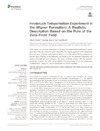Identificador persistente para citar o vincular este elemento:
https://accedacris.ulpgc.es/jspui/handle/10553/77259
| Campo DC | Valor | idioma |
|---|---|---|
| dc.contributor.author | Casado, Alberto | en_US |
| dc.contributor.author | Guerra Guillén, Santiago Ramón | en_US |
| dc.contributor.author | Plácido Suarez, José | en_US |
| dc.date.accessioned | 2021-01-19T15:23:20Z | - |
| dc.date.available | 2021-01-19T15:23:20Z | - |
| dc.date.issued | 2020 | en_US |
| dc.identifier.issn | 2296-424X | en_US |
| dc.identifier.other | Scopus | - |
| dc.identifier.uri | https://accedacris.ulpgc.es/handle/10553/77259 | - |
| dc.description.abstract | In this article, an undulatory description of the Innsbruck teleportation experiment is given, grounded in the role of the zero-point field (ZPF). The Wigner approach in the Heisenberg picture is used, so that the quadruple correlations of the field, along with the subtraction of the zero-point intensity at the detectors, are shown to be the essential ingredients that replace entanglement and collapse. This study contrasts sharply with the standard particle-like analysis and offers the possibility of understanding the hidden mechanism of teleportation, relying on vacuum amplitudes as hidden variables. | en_US |
| dc.language | eng | en_US |
| dc.relation.ispartof | Frontiers in Physics | en_US |
| dc.source | Frontiers in Physics [EISSN 2296-424X], v. 8, (Diciembre 2020) | en_US |
| dc.subject | 22 Física | en_US |
| dc.subject | 531204 Educación | en_US |
| dc.subject.other | Bell State Measurement | en_US |
| dc.subject.other | Local Realism | en_US |
| dc.subject.other | Parametric Downconversion | en_US |
| dc.subject.other | Teleportation | en_US |
| dc.subject.other | Wigner Representation | en_US |
| dc.subject.other | Zero-Point Field | en_US |
| dc.title | Innsbruck Teleportation Experiment in the Wigner Formalism: A Realistic Description Based on the Role of the Zero-Point Field | en_US |
| dc.type | info:eu-repo/semantics/Article | en_US |
| dc.type | Article | en_US |
| dc.identifier.doi | 10.3389/fphy.2020.588415 | en_US |
| dc.identifier.scopus | 85098245730 | - |
| dc.contributor.authorscopusid | 7005832801 | - |
| dc.contributor.authorscopusid | 56274101900 | - |
| dc.contributor.authorscopusid | 15822921700 | - |
| dc.identifier.eissn | 2296-424X | - |
| dc.relation.volume | 8 | en_US |
| dc.investigacion | Ciencias Sociales y Jurídicas | en_US |
| dc.type2 | Artículo | en_US |
| dc.utils.revision | Sí | en_US |
| dc.date.coverdate | Diciembre 2020 | en_US |
| dc.identifier.ulpgc | Sí | en_US |
| dc.contributor.buulpgc | BU-EGB | en_US |
| dc.description.sjr | 0,754 | |
| dc.description.jcr | 3,56 | |
| dc.description.sjrq | Q2 | |
| dc.description.jcrq | Q2 | |
| dc.description.scie | SCIE | |
| item.grantfulltext | open | - |
| item.fulltext | Con texto completo | - |
| crisitem.author.dept | GIR IDeTIC: División de Ingeniería Térmica e Instrumentación | - |
| crisitem.author.dept | IU para el Desarrollo Tecnológico y la Innovación | - |
| crisitem.author.dept | Departamento de Didácticas Específicas | - |
| crisitem.author.orcid | 0000-0002-9918-297X | - |
| crisitem.author.orcid | 0000-0001-6801-735X | - |
| crisitem.author.parentorg | IU para el Desarrollo Tecnológico y la Innovación | - |
| crisitem.author.fullName | Guerra Guillén, Santiago Ramón | - |
| crisitem.author.fullName | Plácido Suarez, José | - |
| Colección: | Artículos | |
Citas SCOPUSTM
1
actualizado el 08-jun-2025
Citas de WEB OF SCIENCETM
Citations
1
actualizado el 08-jun-2025
Visitas
97
actualizado el 27-ene-2024
Descargas
189
actualizado el 27-ene-2024
Google ScholarTM
Verifica
Altmetric
Comparte
Exporta metadatos
Los elementos en ULPGC accedaCRIS están protegidos por derechos de autor con todos los derechos reservados, a menos que se indique lo contrario.
